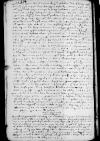Letter #1738
[Ioannes DANTISCUS] to [Dietrich von RHEDEN]Graudenz (Grudziądz), 1537-10-01
English register: Dantiscus is replying to Rheden’s letter. He thanks him for his efforts concerning the coadjutorship, but in connection with the death of Warmia bishop Maurycy (Ferber) he asks him to give up the matter and immediately start dealing with the formalities related to the papal provision for Dantiscus, postulated by the Chapter for the Warmia bishopric, and for Tiedemann Giese, postulated for the Chełmno bishopric. He encloses the Chapter’s resolution on the election and the required documents. He lists specific instructions and information concerning the sending of further documentation and funds to Rome. Dantiscus thanks Rheden for the news. He informs him about the prince of Holstein’s coronation as king of Denmark, which took place in Copenhagen. He points out the lack of a sacral aspect to the ceremony. He also mentions that the Danish bishops remain in prison. Given the customs and nature of the Danes, Dantiscus is doubtful whether the new king will retain the throne for long. Dantiscus is convinced that the spreading of Lutheranism in neighboring areas (the Duchy of Prussia) could only be stopped by the speedy convening of the General Council. Postscript: Dantiscus thanks Rheden for obtaining the privilege concerning the Roman canonical hours and promises to cover the costs involved. He informs Rheden that since serious difficulties have emerged, he will no longer try to obtain a dispensation from spiritual kinship. Dantiscus asks Rheden to sound the pope out on whether the decision in whose favor he will resign from the Warmia canonry and prebend could be left to him. If this can be arranged, he will be extremely grateful.
| received [1537-11-12] Manuscript sources:
Prints:
| ||||||||||||||
Text & apparatus & commentary Plain text Text & commentary Text & apparatus
Venerabilis et Eximie Domine, Frater et Amice carissime. Salutem et omnis felicitatis accessum.
ms 2 3 4 Litteras,
ms 1 [Litteras] paper damaged⌈Litterasms 2 3 4 Litteras,
ms 1 [Litteras] paper damaged⌉ Dominationis Vestrae XXV Augusti
ms 1 Lub[a]viensi paper damaged⌈Lubaviensims 2 3 4 Lubaviensi,
ms 1 Lub[a]viensi paper damaged⌉
ms 1 qu[as] paper damaged⌈quasms 2 3 4 quas,
ms 1 qu[as] paper damaged⌉ possum gratias, aliquando per omnem occasionem, quoad eius a me fieri po(teri)t, relaturus. Ceterum, cum negotium
hoc per mortem r
ms 1 aliu[d] paper damaged⌈aliudms 2 3 4 aliud,
ms 1 aliu[d] paper damaged⌉ nobis agendum restat. Mitto igitur iis iunctum postulationis
decretum cum instrumento procuratorio atque cum litteris regiis ad
ms 1 Tideman[nus] paper damaged⌈Tidemannusms 2 3 4 Tidemannus,
ms 1 Tideman[nus] paper damaged⌉ Gise
Pro novis, quae Dominatio Vestra scripsit, magnam habeo gratiam. Hic aliud non habemus, quam quod prope festum divi Bartholomei[1] in
Ex
Postscript:
Pro indultu ad dicendum horas Romanas gratias habeo, quodcumque pro signatura Dominatio Vestra impendit, faciat, quod sciam – cum gratitudine ut Dominationi Vestrae satisfiat curabo. De dispensatione cognationis spiritualis non est, quod Dominatio Vestra agat.[4] Evanuit hic et quaedam vix magis ardua. Si canonicatus
et praebenda mea Varmiensis sic mihi posset reservari a

 BCz, 244, p. 268
BCz, 244, p. 268